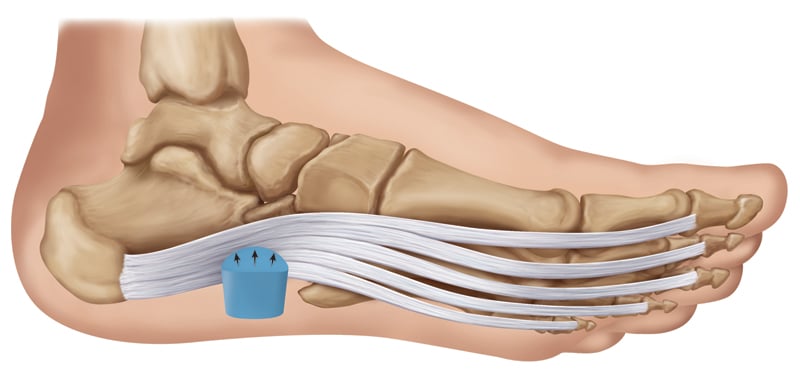in the condition of plantar fasciitis the elastic plantar fascia
Plantar Fasciitis: Symptoms, Treatment and Prevention

In this final article in the two part series on Plantar Fasciitis, Brad Walker talks about the normal symptoms of the painful sports accident as well as the utmost effective treatments once diagnosed. Brad also describes some very important preventative measures that are crucial to avoid Plantar Fasciitis. A ft . injury such as plantar fasciitis generally occurs in one foot. Bilateral plantar fasciitis is different and tends to be the result of a systemic arthritic condition that is remarkably rare among sportsmen. Males have problems with a somewhat higher incidence of plantar fasciitis than females, perhaps therefore of higher weight in conjunction with greater quickness and floor impact, as well as less overall flexibility in the ft ..Typically, the patient of plantar fasciitis activities pain upon increasing after sleep, particularly the first step out of foundation. Such pain is securely localized at the bony landmark on the anterior medial tubercle of the calcaneus. In some cases, pain may avoid the sportsman from walking in a standard heel-toe gait, leading to an abnormal walk as means of payment. Less common regions of pain include the forefoot, Calf msucles, or subtalar joint.After a limited period of walking with this type of ft . injury, the pain usually subsides, but returns again either with vigorous activity or prolonged standing or walking. Around the field, an altered gait or irregular stride structure, along with pain during working or jumping activities are tell-tale indications of plantar fasciitis and really should be given fast attention. Further signs of the accident include poor dorsiflexion (lifting the forefoot off the bottom) anticipated to a shortened gastroc organic, (muscles of the leg). Crouching in a full squat position with the only real of the foot flat on the ground can be used as a test, as pain will preclude it for the athlete suffering from plantar fasciitis, leading to an elevation of the heel due to tension in the gastroc complex.TreatmentTreatment of plantar fasciitis may also be a slow and aggravating process. An application of treatment should be undertaken by using someone experienced and proficient in the affliction. Typically, plantar fasciitis will demand at least six weeks or more to six months of conservative health care to be totally remedied. Should such efforts not provide alleviation to the athlete, more hostile steps including surgery may be looked at.The initial goals of physical remedy ought to be to increase the passive flexion of the ft . and improve versatility in the foot and ankle, eventually leading to a full return to normal function. Prolonged inactivity in vigorous sports is usually the price to be paid for thorough recovery. 50 percent measures can result in a persistent condition, in some instances severely limiting athletic ability.As a large amount of time is spent in bed during sleeping hours, it's important to ensure that the linens at the base of the foundation do not constrict the foot, resulting in plantar flexion where the foot is bent straight out with the toes pointing. This constricts and in that way shortens the gastroc organic, worsening the problem. A heating system pad put under the muscles of the leg for a few minutes prior to rising may help loosen tension, increase blood flow in the lower leg and reduce pain. Also while asleep, a evening splint can be utilized in order to hold the ankle joint in a neutral position. This may aid in the recovery of the plantar fascia and ensure that the ft . won't become flexed during the night.Careful attention to footwear is crucial in avoiding foot injuries. Every effort should be made to wear comfortable shoes with proper arch support, fostering proper foot posture. Should arch facilitates prove insufficient, an orthotic footwear is highly recommended. Fortunately, most cases of plantar fasciitis react well to non-operative treatment.Recovery times however fluctuate enormously from one athlete to another, depending on get older, general health and health as well as seriousness of injury. A wide period between 6 weeks and 6 months is usually sufficient for proper therapeutic. Additionally, the mode of treatment must be versatile depending on the details of a specific athlete?s damage. Methods that show successful in one patient, might not exactly improve the personal injury in another.Early treatment of ft . injuries typically includes the use of anti-inflammatory medication, icing, stretching activities, and heel inserts and splints. Cortisone shots may be essential to achieve satisfactory curing and retard infection. In later phases of the rehabilitation process, typically after the first week, snow should be discontinued and substituted with heating and massage.It is imperative that any activity recognized to produce soreness or trauma to the plantar fascia be immediately discontinued, including any activity concerning repeated impact of the heel on a difficult surface, particularly, operating. Should pain from the harm persist, additional diagnostic studies should be undertaken to eliminate other, more spectacular causes of heel pain including stress fractures, nerve compression injuries, or collagen disorders of your skin.
in the condition of plantar fasciitis the elastic plantar fascia's Picture
Related Images with in the condition of plantar fasciitis the elastic plantar fascia
plantar fasciitis symptoms

Arch Pain? Easy SelfTreatment PhysioPrescription

in the condition of plantar fasciitis the elastic plantar fascia

Treatments for Plantar Fasciitis and Heel Spurs: Night Splints





0 komentar: